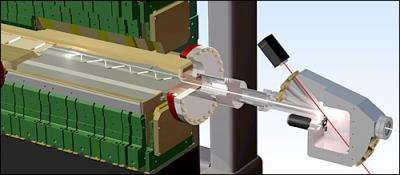To the Edge of Melting

Picking a relatively simple system, SLAC scientists and their collaborators used advanced tools to see the very first instants of change in a solid brought to the edge of melting. Their results appear in the February 2 issue of Science.
The experiment also demonstrated an important timing technique and was one of the last endeavors at the now-dismantled Sub-Picosecond Pulse Source (SPPS)—a proving ground for the more powerful Linac Coherent Light Source (LCLS) now under construction at SLAC. Being able to agitate a material with a laser pulse and then immediately measure its altered state with x-rays opens up an exciting world for researchers concerned with more complex systems that could prove helpful to medicine, clean energy and other fields.
When a laser pulse strikes a semi-metal called bismuth, it disturbs the material's electrons. Because the laser energy is not enough to melt bismuth, the electrons relax back to their normal state in less than a nanosecond. But what happens in between?
"We had to be quick to figure it out," said lead author David Fritz, who worked on the project as a University of Michigan student and is now an instrument scientist for LCLS.
The laser, the x-ray pulses and the atoms themselves operate on femtosecond time scales—quadrillionths of a second. Scientists need to know exactly when the laser fired and when the x-rays swooped through, so that the picture they assemble from the data is chronologically ordered. The authors utilized an electro-optic crystal to time-stamp the arrival of each x-ray pulse, solving a difficult problem: while lasers can be pulsed in steady, reliable intervals, x-rays from a linear accelerator cannot, and thus require a "stop-watch" to mark their arrival time.
The laser instantly changes bismuth's potential energy surface—a measure of the forces that hold solids together—thus weakening bismuth's atomic bonds. This puts the atom's nucleus out of equilibrium, like moving a marble from the center of a bowl up its sloped sides. To get back into equilibrium, the atom "rolls" to the center of the bowl and oscillates around the lowest point, like a marble before it comes to rest in the center of the bowl. The researchers measured the frequency of these oscillations to determine the forces that bind the atoms together.
The results also back a theoretical framework used to predict potential energy surfaces for systems that are in equilibrium. The framework, with simple modifications, surprisingly worked for the out-of-equilibrium bismuth system as well.
This is the first time-dependent mapping of a solid's potential energy surface. But with the advent of LCLS close by, researchers can look forward to making and understanding many more such maps.
Source: by Heather Rock Woods, Stanford Linear Accelerator Center




















